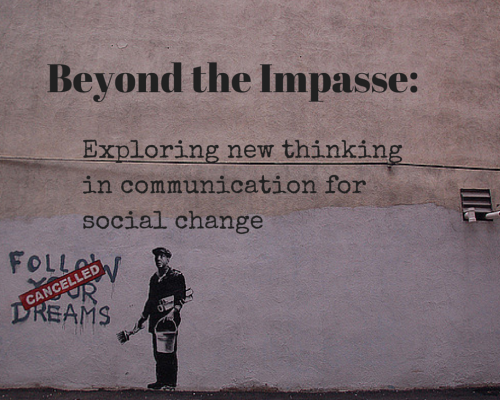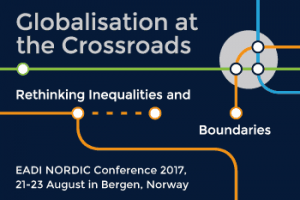New Thinking in Communication for Social Change

Recently released Special Issue of Nordicom Review syndicates innovative perspectives on theory and practice in the field of communication for social change, shedding light on its development from various perspectives.
“Many of us working in this area have recognized that some of the more interesting theoretical developments in this area have occurred either on the margins of communication for social change theory or wholly outside of it,” writes editor Dr Pradip Ninan Thomas about the incentive for this publication.
The Special Issue Beyond the Impasse: Exploring new thinking in communication for social change is a resume of ideas discussed at Beyond the Impasse conference organized by the Centre for Communication and Social Change, University of Queensland in January 2013. It also resonates with the earlier Nordicom Special Issue Communication, Media and Development. Problems and Perspectives, edited by Florencia Enghel and Karin Wilkins.
The new publication includes insights on the relation between the state and citizens; dimensions of participation; power of images and video; sustainability of the field and much more, giving an opportunity for further reflections on the present and future of the communication for social change. Florencia Enghel, a Vice-Chair of the Participatory Communication Research Section of IAMCR, in her article invites readers to apply a political economy approach to see how it can benefit the development communication in its dimensions of a study, a practice and an institutional project.
Media assistance of the field is assessed by a Postdoctoral Research Fellow at RMIT University in Melbourne Jessica Noske-Turner who analyzed nearly 50 evaluation documents of programs and projects during 2002-2012. She concludes that the pivotal problem of the evaluation documents is a lack of adaptability and flexibility.
Tamara Plush, a PhD candidate at the Centre for Communication and Social Change, University of Queensland, Australia, elaborates on institutional norms in the practices of participatory video that should serve as consideration points for intensifying efforts to raise citizen voices. A response of practitioners to the institutional views, Tamara Plush writes, “requires interrogating how their own views might play a parallel, influential role through varying degrees of response from compliance to resistance”.
More insights and interesting perspectives on theory and practice of the field could be found in the Special Issue of Nordicom Review Beyond the Impasse: Exploring new thinking in communication for social change here.
Image via Flickr
 New PhD opportunities at the University of Leicester
New PhD opportunities at the University of Leicester Call for Abstracts: New Directions in Media, Communication and Sociology (NDiMS) Conference
Call for Abstracts: New Directions in Media, Communication and Sociology (NDiMS) Conference Ørecomm Team to Gather at the University of Coimbra
Ørecomm Team to Gather at the University of Coimbra “Communication and Social Change – A Citizen Perspective” Published
“Communication and Social Change – A Citizen Perspective” Published C4D Network to Sum Up Global Communication for Development Practice
C4D Network to Sum Up Global Communication for Development Practice Entering Media and Communication into Development Conferences?
Entering Media and Communication into Development Conferences? IAMCR Conference 2016: Communication for Development Highlights
IAMCR Conference 2016: Communication for Development Highlights Glocal Classroom Revisited – Storytelling & Social Change Leicester-Malmö
Glocal Classroom Revisited – Storytelling & Social Change Leicester-Malmö I EvalComDev International Conference: Call for Papers
I EvalComDev International Conference: Call for Papers Looking for Media and Communication in Development Conferences: Devres 2016
Looking for Media and Communication in Development Conferences: Devres 2016